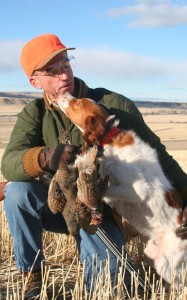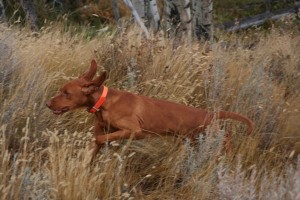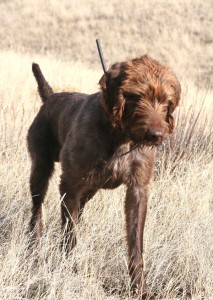 My friend Tony's setter is nothing special to look at. She's short, with a slightly pushed up nose, as if a pug somehow snuck into her pedigree a few generations ago. She's a muddy tricolor, built close to the ground, and at 10 years old is rapidly slowing down, no longer the freewheeling ground eater she was in her prime.
My friend Tony's setter is nothing special to look at. She's short, with a slightly pushed up nose, as if a pug somehow snuck into her pedigree a few generations ago. She's a muddy tricolor, built close to the ground, and at 10 years old is rapidly slowing down, no longer the freewheeling ground eater she was in her prime.
But she's been hunting nothing but chukars her whole life, day in and day out, from the torrid, rimrock heat of September through the brittle, snow-spitting days of December and January. Hunting over her is a lesson in exploded expectations: rather than waste time and energy casting back and forth, she simply jogs patiently from one covey to the next and points them where they live. Tony thinks she's one of the best chukar dogs he's ever owned. I wouldn't disagree. And I wouldn't put my best dog up against that little setter on a bet.
So what makes that dog great? Well, the simple answer — and the indisputable truth — is that she does her job exceedingly well. Beyond that, though, her qualities are a bit harder to define. Is it her range and speed? Nope. How about her nose? Could be. Her style? Probably not. Experience? Absolutely, but€¦
So how, exactly, do you define a great bird dog? In the field trial world, great dogs have a definite numerical value: such and such a dog has won X number of national championships, so by common consensus it is a great dog. (Not incidentally, it's also going to be an expensive dog, but that's another topic entirely.)
But we in the gritty world of seat-of-the-pants, blue-collar bird hunting are far more subjective. Some folks like big running, flashy dogs; some don't. Some like a 12 o'clock tail on point; the owners of Brittanys, shorthairs and versatiles would beg to differ. Perhaps George Hickox said it best: "I want a dog that runs and hunts in a way that pleases me."
Fast Pace
There are so many variables to consider when discussing the speed of a dog that I'm already starting to backpedal like a philandering politician.
I used to believe that a hard-charging dog would somehow "freeze" spooky birds in their tracks, effectively holding them until I was able to amble up for a leisurely shot. After all, that's what I'd always been told.
Problem was, it never really worked that way. Dogs that are hell-bent-for-leather can also overrun their noses, blowing by coveys that a slower, slightly more methodical dog would probably scent. So, strictly from the standpoint of finding birds, there's no physical advantage to owning a dog that runs like the wind. All other things being equal, a slow-moving dog will find just as much game as a barn burner, although it will probably take him longer.
On the other hand, how a dog looks while it's running is something I care deeply about, so I've always leaned toward dogs that move at a snappy (if not breathless) pace and handle birds with intensity.
 Close Range
Close Range
The accepted wisdom is that open country dogs should run far and wide and thick cover dogs should work much closer. With that in mind, I spent years running 500- and 600-yard dogs on the prairies of Montana, where I do most of my hunting. Then I had a complete reevaluation of priorities: I started adding up the prairie birds (Huns and sharptails) my aging Brittany had pointed, and discovered, despite her limited range (100 to 200 yards, typical for the breed), she probably found more birds by a factor of two to one than any other dog I've owned.
Based on her and other moderate-range dogs I've hunted over, I now think a dog that ranges out to 200 yards or a bit more in wide open country is plenty big enough and will find just as many birds as a dog that runs at twice that distance. What's more, at that moderate range I actually get to watch my dog hunt once in a while.
Thick, dense cover, of course — the kind that ruffed grouse, woodcock, pheasants and some of the quails live in — is a whole 'nother ballgame. For those birds, close-ranging dogs are the cat's pajamas. But it's easy to go overboard. Some folks — you know who you are — can't bear the thought of hunting over a dog they can't always see. That means they're uncomfortable with a dog that ranges much beyond 25 yards or so.
That's simply too close in almost any kind of cover. The advantage of a pointing dog over a flushing dog is that it will punch out there and find birds you would have missed otherwise. So a dog that closes down to somewhere between, say, 25 yards at the closest and 100 yards at the farthest is, in my opinion, tough to beat in the thick stuff.
Scent Lock
A great bird dog should have a great nose. Now tell me this: exactly how do you determine that? In February and March, after the regular hunting season is over, my friends and I, minus our guns, run our dogs on the prairies for "spring Huns." By mid-February, Hungarian partridge are pairing up and hold like bobwhite quail, making for grand sport and excellent dog training.
A couple days ago, I had one of my setters down on a farm I knew held some birds. Hanna, who at 6 years old has probably pointed thousands of Huns, ran upwind through three pairs of Huns, which she evidently never knew were there.
On the other hand, a setter I owned a number of years ago, and a dog who wasn't half the bird finder Hanna is, once pointed a covey of Huns from 500 yards away. So what does that say about her nose?
All this nose business talk is overblown, in my opinionated opinion. There are more important things. Your dog's nose — whatever you own — is almost certainly good enough.
Training Smarts
Now we're getting somewhere. The late Bob Wehle once remarked — and this isn't an exact quote — if he'd increased the intelligence of the dogs in his breeding program over the years, he was doing something right. I couldn't agree more.
A highly intelligent dog with just average speed, nose and range can develop into a spectacular bird finder. My aging Brittany, whom I mentioned earlier, fits that description perfectly. And, unlike nose, intelligence can be determined simply by observing the dog as you're training it.
Does he learn his lessons quickly? Does he improve from year to year in his ability to find and point birds? Both are solid indications of an intelligent dog.
Intelligence will allow a dog to compensate for other weaknesses in a way a less intelligent animal might never be able to do. But this isn't something you can train into your dog; it has to be there from birth. Which is another way of saying that good breeding matters€¦a lot.
 Field Time
Field Time
Over the course of a dog's lifetime, it is experience and intelligence, one trait working to bolster the other, that produces the dogs you remember. The smartest, snappiest, best bred and most highly trained hunting dog on earth won't amount to a hill of beans if he hunts only twice a season.
I've seen more dogs than I can count — good, solid pointing dogs that most hunters would be happy to own — who got that way in spite of their lack of training or physical skills simply because their owners hunted them several days a week, all season long, year after year.
I'm not suggesting anyone forgo training in favor of time in the field; in fact, I think that's a big mistake. But you probably need to get your pup out at least a couple dozen times a season if you want him to build on what he knows and improve.
Style Standards
Style varies with the breed, so I'm going to keep this short. How a dog runs and how he handles birds constitutes his style. Wirehairs, Brittanys and English pointers have different styles because they're supposed to have different styles; that's how they've been bred. Judging one breed by the standards of another isn't fair to either.
Buy a dog from a breed you love to hunt over, and you'll love its style, too. And that's as least as important as what anyone else, including snooty dog columnists like me, may think.






